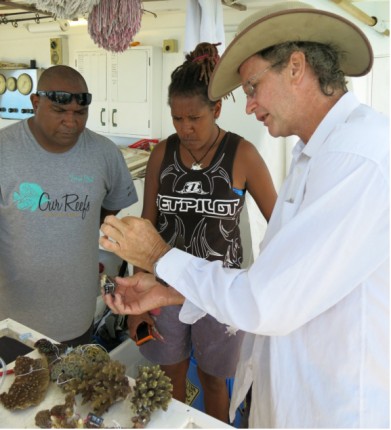Coral Biodiversity in Torres Strait: Why did we collect coral specimens?
During trips to Torres Strait in collaboration with TSRA in 2013 and 2014 coral skeletons were collected under a permit issued by the Commonwealth of Australia under the Torres Strait Fisheries Act 1998. The permit specified the collection of small pieces of the coral skeleton for identification purposes.
The corals collected have been deposited at the Museum of Tropical North Queensland. They are part of a global scientific collection and are not being used for commercial purposes. An exhibit of corals is housed the public area of the museum in Townsville, where visitors can view coral skeletons and learn more about coral biology. Collections of species held by museums contribute to the ongoing process of learning about the earth's biodiversity and further humanity's knowledge of coral reefs. By helping scientists working on coral reefs identify corals the museum collection can help ensure that experimental studies on coral reefs are accurate and meaningful.
Whereas some animals and plants from coral reef environments can be easily identified without collecting, this is often not the case for corals. Many corals can only be identified from the skeletal features once the live tissue has been removed. The skeletal features are small and cannot be seen with the naked eye. Only a small piece of coral is collected for this purpose and since most corals are colonies of thousands of individual polyps, we do not actually "kill" any coral. The coral colony quickly regrows in much the same way that a plant does when a small branch is removed.
Another reason of collecting small samples is that the taxonomy or identification of corals is still being worked on. Corals are very unusual in that their growth form varies widely within one species and the boundary that determines where one species ends and another starts is not yet clear. Genetics are now being used to try and clarify coral taxonomy but it is a work in progress. Therefore, researchers try and collect samples from a variety of locations and habitats to help this process and to allow their data to be updated as the coral taxonomy becomes better.
No genetic samples were taken in 2013 but in 2014 museum expert Dr Paul Muir co-ordinated the collection program and took genetic samples from the corals he collected. Analyses of the genetic samples are used in new research that looks at how different coral species are related and if the current classification scheme for corals is actually correct.
There are now over 200 coral skeletons from Torres Strait in the MTQ collection. The first collections date from the early 1980's, collected by AIMS and identified by Dr Carden Wallace. Dr Muir collected 97 specimens in 2014. He identified 80 species from these specimens and recorded another 90 species from field identifications.
The corals collected in 2013/14 are a partial snapshot of the biodiversity of corals species in Torres Strait. Corals are vulnerable to climate change and there is a very real chance of losing species. Torres Strait is potentially a very significant area where to date there have been fewer major impacts on the coral communities. To determine the significance and vulnerability of the region accurate biodiversity reporting is necessary.




